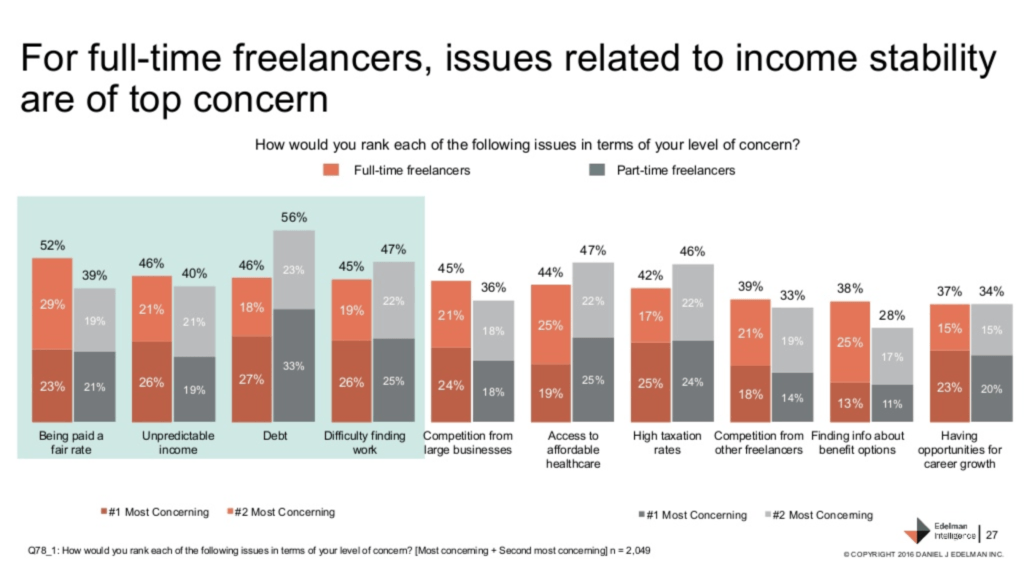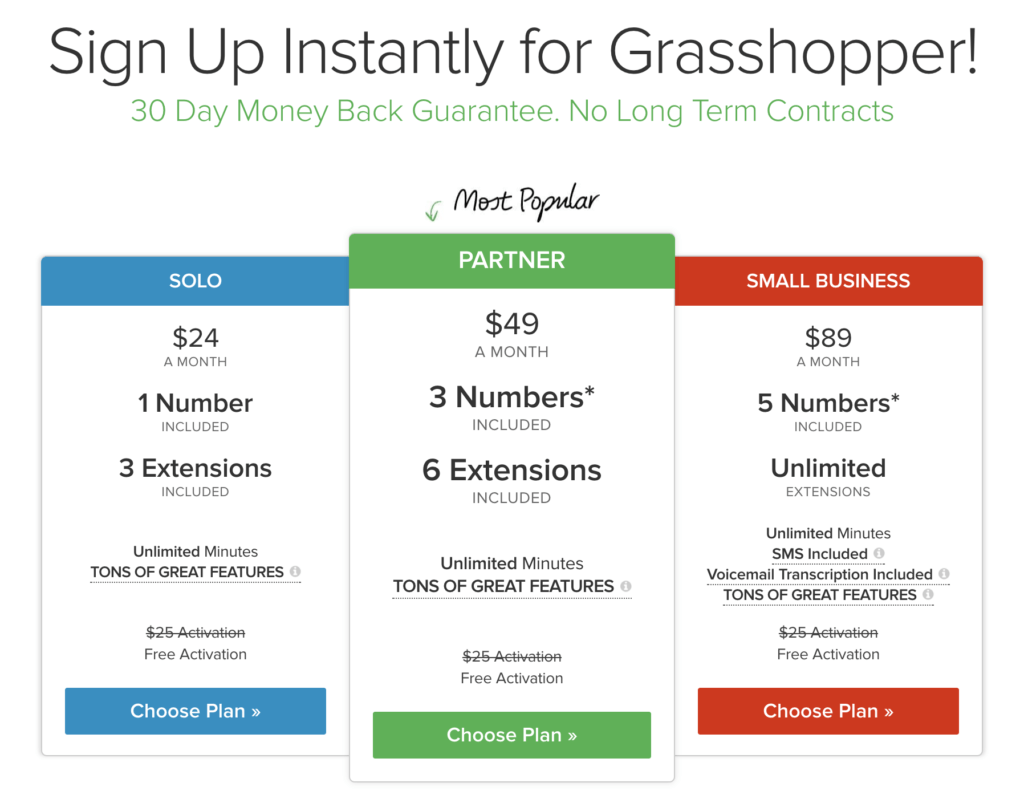Life as a freelancer with a retainer-based business…
Ahhh, wouldn’t that be grand?
Total freedom. Control. A job you love. Crippling anxiety …
Don’t get me wrong, freelancing can be amazing.
No more horrible boss or soul-crushing commute. You can choose what projects you work on, who you work with and when you work.
Well, when it’s working like a well-oiled machine, that is.
When you’re not wondering how you’ll pay next month’s rent. When you don’t start each month with reliable earnings of $0.00. When you’re not thinking, “Maybe a job with a salary might not be so bad … ”
Living paycheck to paycheck can leave a person frayed.
According to Upwork’s “Freelancing In America 2016” survey, the top concern of full-time freelancers is income stability.

Thankfully, there’s a simple solution to unpredictable income.
And it doesn’t involve robbing banks or winning the lottery.
It’s called a monthly retainer.
Okay, I know it doesn’t sound as exciting as winning the lottery, but it is. Because it’s basically winning the lottery.
A retainer is an agreement where the client retains the accessibility or services of the freelancer on an ongoing basis.
Sounds good, right?
A retainer is the closest thing to a salary for a freelancer.
As six-figure freelancer Chelsea Baldwin shares:
“When you work on a retainer agreement … you don’t start out at $0.00. Instead, you can start out with half or more of your monthly income already accounted for.”
Arguably, retainers are more secure than a salary because you can have many clients on retainer at the same time.
Eggs in different baskets and all that.
Crucially, you don’t have to spend so much time pitching, landing and securing new clients. Also, admin tasks like invoicing are easier because they’re predictable and regular.
Retainers are the way to make more money as a freelancer.
Why?
Because they allow you to leverage your value.
There’s only so many hours in the day, but the amount of value you can create has no limit.
According to Payoneer, the average freelancer charges $21 per hour, and only 18% of freelancers charge over $30 per hour (worldwide).

But the average digital marketing industry fee for a monthly retainer contract is between $1,000 and $3,000.
So throw that crippling anxiety out of the window. Freelancing really is awesome.
You just need to get it working like a well-oiled machine.
Retainer-based business will steady your cash-flow, and allow you to earn even more money.
What’s not to love?
1. Get Your Foot In The Door and Build Trust
A new client is extremely unlikely to commit to a monthly retainer for an unproven freelancer.
They need to get a taste of what they’re buying — you need to take them on a few dates before you get down on one knee.
Arthur Gensler, founder of the design and architecture firm Gensler, writes on Fortune, “Trust is the most powerful currency in business.”
Freelance designer Robert Williams agrees:
“When a client decides to hire you, trust is all that matters. Can you be trusted to deliver high-quality work, meet deadlines — and above all — not run off with their money?”
This is why so many subscription-based businesses provide a trial period, like Dropbox. The file hosting service provides a 30-day free trial of their software in the hope that users will like it enough to upgrade to a paid plan.
Even the person at your local dog shelter will say, “Just take him home for a week and if you’re still not sure, bring him back.”
(Spoiler alert: No one ever does.)
So work for a new client on a project-by-project basis first, and use the time to build trust and prove your worth by:
- Never missing a deadline
- Overdelivering
- Going outside of what you were hired to do to add more value
- Being adorably cute like a puppy so they’ll want to keep you
And then, offer them a retainer deal as a trial month first. If they’re unsatisfied, they can cancel at any time.
But remember, trust works both ways.
Imagine a nightmare client. One who is slow to respond, pay or collaborate but quick to criticize, undervalue and ask for more work than you initially agreed upon.
Now imagine having to deal with this client month after month.
Nope. No thanks.
Han-Gwon Lung, CEO and co-founder of Tailored Ink, wrote in an article on Entrepreneur:
“Many freelancers accept any client who comes their way because they’re worried that the party will abruptly stop. But this is a scarcity mentality, and it’s always a bad idea.”
So listen to your gut.
There are plenty of amazing clients out there. Don’t let fear pressure you into chasing retainers with nightmare clients.
Freelance technical writer and editor Leah Hackleman-Good, P.h.D., says:
“Choosing clients carefully for this work is key; don’t offer it to clients who routinely question your hours or have other ways they’ve nitpicked your invoices.”
If you choose the right clients and build trust, you’re already halfway there.
2. Deliver Value To Your Clients
The key to selling clients on a monthly retainer? Good ol’ fashioned value.
Remember, the point of a retainer is to establish a mutually beneficial long-term arrangement.
Keyword: Mutual.
It’s easy for a client to understand why a retainer would be great for you — but what’s in it for them?
Think about it: There are things we use regularly where a subscription makes sense, like Wi-Fi, cable TV or your phone.
And then there’s things like haircuts, pizza and shoes, which we only want to pay for when we need them.
You need to prove to your clients that they’ll get more value from you if they engage your services every month.
And with a twist, almost every product or service can be offered as a subscription.
Think of Dollar Shave Club razors, or clothing subscription companies like Le Tote or Five Four Club.

So ask yourself: “What value can I bring to a client regularly?”
If you’re about to freeze up like a fainting goat, don’t worry — you almost certainly have something to offer.
Obviously, some professions are more geared towards retainers than others. Most freelancers will need to add additional services to their usual offerings.
Think about the type of work you could do on a recurring basis, like:
- Planning or strategy consulting
- Being on call for emergency issues
- Routine maintenance work
- Ongoing reporting and/or monitoring
For example, after building a website for a client, web developers could offer ongoing services like:
- Technical support
- Bug fixes
- Routine maintenance/updates
- Coaching for employees on how to update the website
- Enhancements in design/content based on feedback/testing
Even if you’re in a mostly project-based niche, you can still sell your clients on a monthly retainer — for example, a set number of articles per week.
Ask yourself this: Why should your client hire you on retainer rather than simply hiring someone whenever they need work done?
Then, communicate these benefits to your client. It’s easier than you might think.
How?
Having worked with the client before, you’re already familiar with their needs, workflow, style and business goals.
This alone will save them huge amounts of time, as they won’t have to go through the onboarding process with someone else.
Want to know the best part?
As time goes on, your ever-growing, intimate knowledge of their business will allow you to work more effectively — meaning you can deliver even more value.
Think about your client’s unique situation and create a package of your services that will bring value to their business.
3. Beware of Selling Time
Selling time is a bad idea.
Why?
Because you’ll get faster and more efficient at your job as time goes on.
So if you’re paid by the hour, as you become faster and more effective at your job, it’ll take you less hours to complete the same work, but you’ll get paid less.
That ain’t right.
If you’re delivering more value, you should get paid more money.
Businesses don’t really care how many hours you work anyway. They care about results.
So sell results.
Sell the value you bring to the company.
Here’s another scenario showing the flawed link between time and value:
A client commissions you to write a 2,000-word article.
They’re happy to pay you $200 dollars for it, because — unknown to you — they assume it will take you 4 hours, and deem $50/hour as reasonable.
Do you:
- Say the article will cost $200 to produce.
- Say the article will take you an hour to produce, and will cost $200?
The client would happily accept the first option, but probably balk at the second.
But why? They’re still getting $200 worth of value for $200.
Chris Guillebeau touched on this in his book The $100 Startup.

After paying $50 for an emergency locksmith, he felt shortchanged after the locksmith dealt with his problem so easily.
“I realized that I secretly wanted him to take longer in getting to me, even though that would have delayed me further. I wanted him to struggle with unlocking my car as part of a major effort, even though that made no sense whatsoever.”
“The locksmith met my need and provided a quick, comprehensive solution to my problem. I was unhappy about our exchange for no good reason.”
And time is limited, so if you charge per hour, your income is limited too.
4. Sell Value Instead
Let’s look at how you might structure your proposal to avoid pricing your time.
Say you’re a marketer who aims to earn around $100/hour. These are some of the services you might offer to a client:
Marketing Services, $4,000/month:
- On call emergency consultations for PR issues
- Fast turnaround for product launches, campaigns, etc.
- Ongoing competitive research to identify new opportunities
- Ongoing internal research to identify strengths and weaknesses
- 10 hours of consulting sessions for planning and strategy
- Split-testing, tracking and optimizing the client’s website for conversions
- 2 blog posts per week / 8 per month
- Complete management of the client’s social media channels
- 1 new email campaign a month
- Monthly benchmark reporting
Time was mentioned only once. And that was to limit the number of hours spent in meetings each month.
In this example, the client has no choice but to evaluate the value of those services against the $4,000 price tag.
However, you know these tasks will take you around 40 hours a month to complete. Which is why — at $100/hour — you charge $4,000.
Here’s the kicker.
If the work takes you only 25 hours that month, you dip in — and your client still receives $4,000 worth of value.
So as you get faster and more efficient, your earning potential increases.
Sound good?
When selling value, always include the end goal in your proposal:
“By the end of our six-month contract, our goal is to…
- Generate 500 new leads every month
- Increase website conversions by X%
- Grow the email list to 100,000 people … ”
This demonstrates to your client exactly how they’ll receive a return on their investment.
Start by understanding the financial upside for your client.
“This, more than anything, is the big secret of landing high-dollar engagements,” says six-figure freelancer Chelsea Baldwin.
“It boils down to not being afraid to ask your prospects about their current revenue model, how much they’re making, how much they’re losing out on and how your work should affect those numbers.
Once you know their numbers, you can look at a feasible way your work can improve them and figure out how much they stand to make. For example, if someone will earn a minimum of $30,000 more per year as a result of your work, and you charge $3,000, it’s a no-brainer, isn’t it?
But when you only present your $3,000 price tag without any discussion of how much the client stands to earn back from that investment, it’s no longer a no-brainer—it’s just viewed as a $3,000 expense, which is less likely to get the green light.”
So tie your services to the client’s bottom-line — and how you’ll help grow it.
5. Give Them Options
Up your chances of landing a retainer by offering different bundles of your services.
You’ve seen this a million times.
Take Grasshopper, a virtual phone system provider. They present different packages depending on your needs:

You can follow this approach by creating different packages.
For example:
Web Design Growth Package 1: $1,000/month
- Routine maintenance, updates and technical support
- Minor design changes and layout updates
Web Design Growth Package 2: $2,500/month
- Routine maintenance, updates and technical support
- Minor design changes and layout updates
- 4 hours/month of website management video-call training for employees
- Integration of design elements into social media and email marketing channels and content
Web Design Growth Package 3: $4,000/month
- Routine maintenance, updates and technical support
- Minor design changes and layout updates
- 10 hours of blog management video-call training for employees
- Integration of design elements into social media and email marketing channels and content
- Split-testing to improve UX and conversions
- Tracking and reporting to show how design changes impact key performance metrics
This way, clients can choose the level of services they most need, while also being conscious of their budget.
6. Clearly Define Expectations
What exactly is a “minor update”?
How many split-tests will you run? How long will the weekly consultation be? How many social media posts will you create?
These are the types of questions you will need to answer if you want to avoid the dreaded “scope creep.”
Scope creep refers to continuous or uncontrolled growth in a project’s scope.
And if you’re not careful, it can bury you:
“Great job! Can you add another ‘Contact Us’ button at the bottom of the page?”
“Love it! It would be great if you could also include another paragraph about our recent customer case study — can you knock that out by tomorrow?”
“Fantastic! Could you also add in some of those ready-made click-to-tweet quotes? Just two or three would be ideal!”
Not only does scope creep hurt your soul, it hurts your bank balance and takes time away from serving other clients — and landing new ones.
Baltimore-based writer Michele “Wojo” Wojciechowski says:
“If I hire somebody to paint my office green and I hate it, I have to pay them to paint it purple if I’ve changed my mind. If the editor has changed his or her mind, that is beyond the scope. This isn’t what we talked about. As a result, I would expect additional compensation.”
Scope creep can be particularly difficult to avoid with clients on retainer.
Often these clients will feel like they have some kind of ownership over your time, and will naturally want to squeeze more out of you.
As always, prevention is better than a cure.
The best way to avoid scope creep is to clearly define client expectations before you start working.
Freelancer Greg Ciotti shares an excellent bullet-point list of what to get in writing for your monthly retainer proposals:
- The amount you’re to receive each month
- The date you’re to be paid by
- Any invoicing procedures you’re expected to follow
- Exactly how much work and what type of work you expect to do
- When your client needs to let you know about the month’s work by
- What notification you need before the retainer relationship can be ended
- Anything else that is relevant for ensuring that work is completed in a timely fashion
Make sure you’ve agreed on these expectations and have them in writing.
If you want to take it a step further, you can always create a more comprehensive contract.
Personally, I’m in agreement with Seth Godin. As he writes, “All deals are handshake deals”:
“Specific contracts don’t completely protect you from dishonorable people. What they do is make it really clear about what it takes to do what you said you were going to do.
Start with a good agreement. But your future depends on doing agreements with good people.”
So if you’re considering taking on a client where a comprehensive contract feels necessary, perhaps they aren’t a good client to work with.
Still, clearly defining the terms of the relationship helps both parties achieve satisfaction.
Kristen Fischer, freelancer and author of “When Talent Isn’t Enough,” has a response ready when her copywriting clients ask for work that extends well beyond the original scope:
“This is outside of what we agreed to, but I’m happy to do this for an hourly rate.”
And freelance writer Ilima Loomis responds with something along the lines of:
“I love the idea for this sidebar and I’d be happy to do it! Would you like to shorten the main story to keep the total word count the same, or bump up my fee by TK amount to reflect a longer word count?”
Want to know the best part about clearly defining client expectations?
You can make sure that you hit or exceed them every month — guaranteeing the future of your monthly retainer.
7. Constantly Prove Your Worth
One of the hardest parts about working for a client long term can be maintaining your enthusiasm.
The work can become boring and unchallenging, and so it becomes easy to take their business for granted.
The next thing you know, you’re delivering the bare minimum.
Which is the express ticket to “No-Client-Ville.”
“Here’s the thing: Getting a retainer is one thing, keeping it another,” says sales coach and consultant Mark Wayland:
“I never take the relationship I have with them or their business for granted. In essence, I treat them just like a ‘new’ customer, the only differences being that I have ready access to talking with them and we have a great trusting foundation.
In fact, my best 2 retainer customers have been with me for over 8 years and provided more than $350,000 worth of business.”
The key takeaway? Always treat them like a new client.
As Elizabeth Hanes, a six-figure freelance writer, wrote on Six Figure Nurse:
“Freelance writing is roughly 75% marketing and 25% writing, so if you aren’t willing to sell yourself then you probably won’t succeed in this arena.”
When on retainer, you must sell your services every single month by proving your worth and delivering results.
But how exactly?
Consider creating a monthly “CEO-ready” report for your client that showcases exactly what you did and what effect it had on the company’s goals.
The point is to reiterate why they’re paying you.
First mention the work you did. The details will differ depending on your profession, but they’ll be things like:
- The number of website bugs you fixed
- How many social media posts you shared
- A/B tests you ran and their results
- How many articles you wrote
- The details of the ad campaigns you ran
Next — and this is the important bit — showcase the outcomes you achieved by doing these things.
For instance, when listing the number of blog posts you wrote that month, present the number of readers, email signups or social media shares the articles generated.
Tools like Remarq make it easier to do this.
Ideally, you could showcase these figures in charts or graphs that compare them to last month’s statistics — or even last year’s if you have the data available.
This way, clients can see your value at a glance — letting you maintain that sweet retainer income.
Final Thoughts
Ok, that’s a lot to take in.
But retainers are worth the effort.
They allow you to regulate your income, saving you from the abject terror that hits you each time you remember you have no dependable income next month.
They also let you leverage the value you create to maximize your earning potential.
Take it one step at a time:
- Build trust
- Identify the value you can bring to your client
- Sell them value, not time
- Give them options
- Clearly define expectations
- Constantly prove your worth
If you do these things right, you’ll be well on your way to freelancing freedom.
Freedom from awful bosses, early morning commutes, soul-crushing cubicles and income caps …
It’s basically winning the lottery.
Want More?
In The No Pants Project we teach how to attract and keep premium clients (and even how to turn them into retainer clients, so you don’t have to keep getting new clients!).











